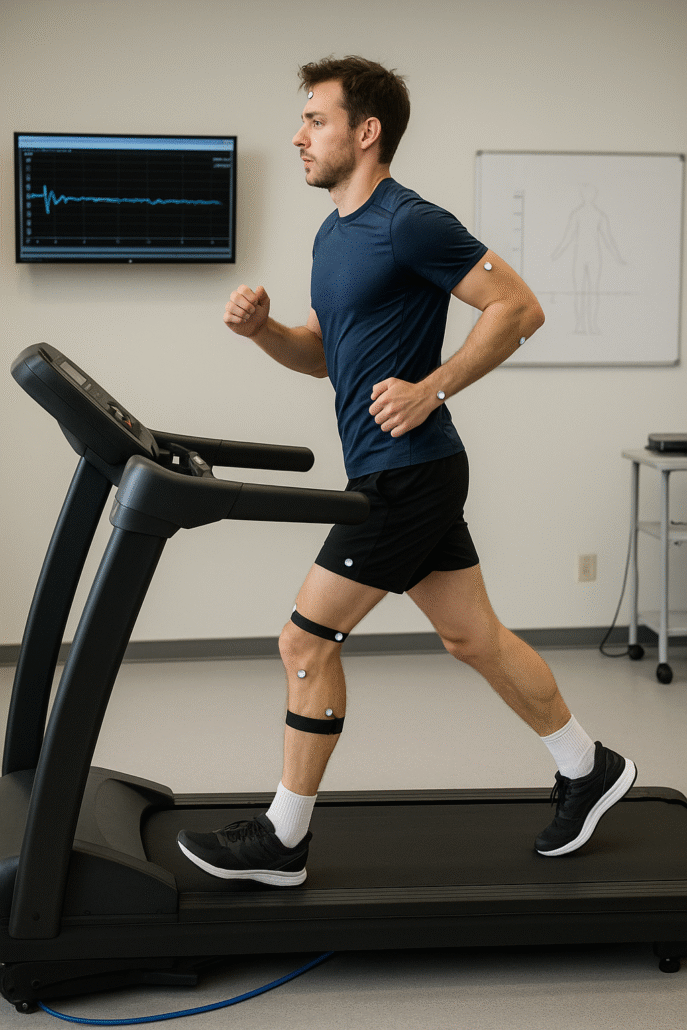We can now offer Treadmill Biomechanics Assessment’s

The Benefits of Biomechanical Assessment on a Treadmill
In the world of running and athletic performance, small inefficiencies in movement can make a big difference — both in speed and in injury prevention. A biomechanical assessment on a treadmill offers runners and coaches a powerful tool to understand how the body moves in real time, helping to optimize technique, reduce injury risk, and enhance overall performance.
1. Real-Time Analysis in a Controlled Environment
Performing a biomechanical assessment on a treadmill allows practitioners to analyse gait and movement patterns under consistent, repeatable conditions. Unlike outdoor running, where variables like terrain, wind, and surface inconsistencies can interfere, treadmill assessments provide a controlled environment. This consistency ensures that data on stride length, cadence, ground contact time, and joint angles is accurate and comparable over time.
2. Identification of Inefficient Movement Patterns
Even experienced runners can develop subtle asymmetries or compensations that reduce efficiency. High-speed video capture and motion analysis software allow experts to observe and measure aspects such as:
- Foot strike type (heel, midfoot, or forefoot)
- Overstriding or crossover gait
- Pelvic tilt or hip drop
- Excessive pronation or supination
By identifying these inefficiencies, practitioners can recommend corrective strategies — from strength and mobility exercises to form adjustments — that improve running economy and reduce fatigue.
3. Early Detection and Prevention of Injuries
Biomechanical issues often precede overuse injuries such as shin splints, IT band syndrome, Achilles tendinopathy, and plantar fasciitis. A treadmill assessment can reveal early warning signs before pain develops. For example, excessive hip internal rotation or knee valgus can point to muscle imbalances that, if left unaddressed, lead to injury. Detecting and correcting these patterns early can save months of recovery time.
4. Personalized Footwear and Orthotic Recommendations
Not all shoes are created equal — and not every runner benefits from the same type of support. A treadmill assessment provides detailed data on how an individual’s feet and legs behave during motion, allowing for evidence-based recommendations on footwear type or orthotic use. This can make a significant difference in comfort, performance, and injury prevention.
5. Objective Data for Tracking Progress
Because treadmill assessments are standardized, they can be repeated periodically to monitor changes and improvements over time. Runners can objectively see the results of technique adjustments, rehabilitation efforts, or strength training interventions. This data-driven approach helps guide ongoing training and ensures that changes are both measurable and meaningful.
6. Performance Optimization for Competitive Runners
For competitive athletes, marginal gains matter. Biomechanical assessments can uncover opportunities to refine posture, stride efficiency, and energy transfer. Improved mechanics often translate into faster running speeds and better endurance, especially over long distances where inefficiencies are magnified.
7. Educational Value and Body Awareness
Perhaps one of the most underrated benefits is the increased body awareness runners gain from seeing themselves move in slow motion. Understanding how one’s body behaves during running fosters mindfulness and better self-correction during training.
Conclusion
A treadmill-based biomechanical assessment is far more than a diagnostic tool — it’s an investment in smarter, safer, and more efficient running. Whether you’re an elite athlete chasing performance gains or a recreational runner aiming to stay injury-free, understanding your biomechanics provides the foundation for long-term success on the road or trail.

